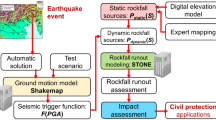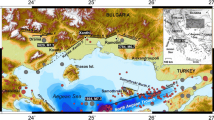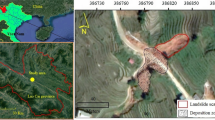Summary
A computer program to simulate the downslope movement of boulders in rolling or bouncing modes has been developed and applied to actual rockfalls triggered by the Mammoth Lakes, California, earthquake sequence in 1980 and the Central Idaho earthquake in 1983. In order to reproduce a movement mode where bouncing predominated, we introduced an artificial unevenness to the slope surface by adding a small random number to the interpolated value of the mid-points between the adjacent surveyed points. Three hundred simulations were computed for each site by changing the random number series, which determined distances and bouncing intervals. The movement of the boulders was, in general, rather erratic depending on the random numbers employed, and the results could not be seen as deterministic but stochastic. The closest agreement between calculated and actual movements was obtained at the site with the most detailed and accurate topographic measurements.
Similar content being viewed by others
References
Azimi, C., Desvarreux, P., Giraud, A., Martin-Cocher, J. (1982): Méthode de calcul de la dynamique des chutes de blocs—Application à l'étude du versant de la montagne de La Pale (Vercors). Bulletin de liaison des L. P. C.122, 93–102.
Bozzolo, D., Pamini, R. (1986): Simulation of Rock Falls down a Valley Side. Acta mechanica63, 113–130.
Falcetta, J. L. (1985): Un nouveau modèle de calcul de trajectoires de blocs rocheux. Revue Française de Géotechnique30, 11–17.
Goodman, R. E., Bray, J. W. (1976): Toppling of Rock Slopes. Proc. Speciality Conference on Rock Engineering for Foundation and Slopes, ASCE/Boulder, Colorado, 201–234.
Hacar Benitez, M. A., Bollo, M. F., Hacar Rodriguez, M. P. (1977): Bodies Falling down on Different Slopes—Dynamic Study. Proc. 9. ICSMFE, Tokyo, 91–94.
Harp, E. L., Tanaka, K., Sarmiento, J., Keefer, D. K. (1984): The May 25–27, 1980 Mammoth Lakes, California Earthquake Sequence—Earthquake-Induced Landslides. U. S. G. S. Map I-1612.
Hoek, E., Bray, J. (1974): Rock Slope Engineering. Inst. Mining & Metallurgy, London, 18–34.
Kobayashi, Y., Shima, M. (1975): Effects of the Off Izu Peninsula Earthquake on Ground. Report on the earthquake off the Izu peninsula, 1974, and the disaster. Shizuoka Univ., 97–101.
Wilson, R. C., Wieczorek, G. F., Keefer, D. K., Harp, E. L., Tannaci, N. E. (1985): Map Showing Ground Failures from the Greenville/Mount Diablo Earthquake Sequence of January 1980, Northern California. U. S. G. S. Map MF-1711.
Author information
Authors and Affiliations
Rights and permissions
About this article
Cite this article
Kobayashi, Y., Harp, E.L. & Kagawa, T. Simulation of rockfalls triggered by earthquakes. Rock Mech Rock Engng 23, 1–20 (1990). https://doi.org/10.1007/BF01020418
Issue Date:
DOI: https://doi.org/10.1007/BF01020418




